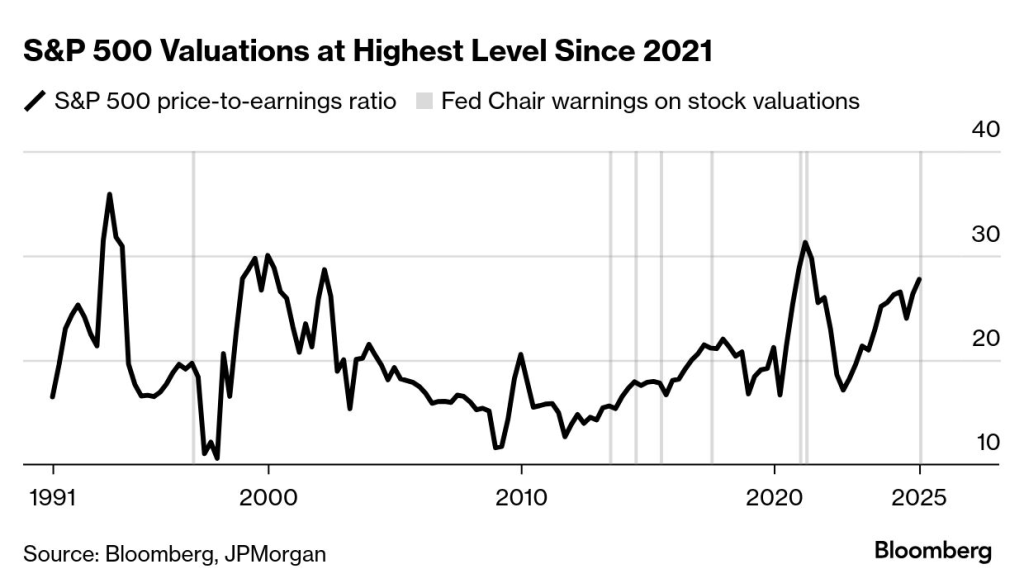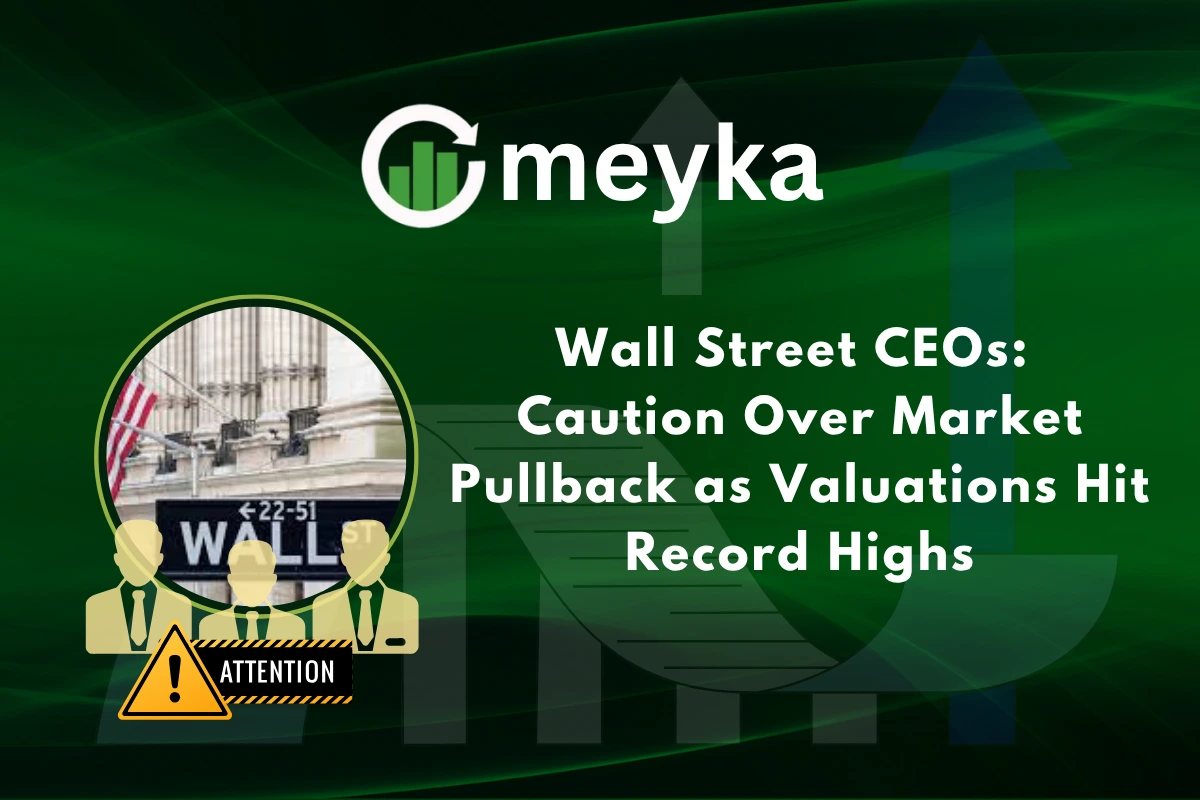Wall Street CEOs: Caution Over Market Pullback as Valuations Hit Record Highs
As of November 4, 2025, top Wall Street CEOs are raising red flags. The U.S. stock market has soared to new highs, with valuations stretched further than we’ve seen in years. S&P 500 and other major indexes are reflecting strong earnings, but also growing investor euphoria.
Executives at firms like Goldman Sachs and Morgan Stanley say a pullback of 10 % or more could be on the horizon. Amid economic uncertainty and lofty price tags, they urge caution. For investors, this means it might be smart to step back, check risk levels, and rethink expectations. The message is clear: record highs don’t guarantee smooth sailing ahead.
Record-High Valuations: The Core Concern
Markets sit near multi-year highs. The S&P 500 and other major indexes pushed into lofty territory in late October and early November 2025. Price-to-earnings metrics now sit well above long-term medians. That gap worries many market watchers. High P/E ratios mean investors pay more today for each dollar of company earnings. When valuations stretch, small disappointments in profit or guidance can trigger sharp moves.

Analysts flag concentration risk, too. A handful of mega-cap firms carry a large share of gains. Those firms are often priced for perfection. If growth slows, the index could fall even if most companies remain steady.
Economic Context: Cooling Growth and Rate Uncertainty
Economic data paints a mixed picture as of early November 2025. Growth is steady but slower than the frothy pace of last year. Inflation shows signs of easing, yet core components remain sticky in places. The Federal Reserve has signaled a cautious stance.
Markets now debate the timing and scale of future rate moves. Higher rates can push down valuations through two channels. First, borrowing costs rise and squeeze margins. Second, future earnings get discounted more heavily. Both effects reduce what investors should rationally pay for stocks today. The result is more uncertainty for portfolios that are priced for low rates.
Voices of Caution: What Wall Street CEOs are Saying?
Top executives have voiced concern in public forums this autumn. JPMorgan’s Jamie Dimon warned of a material correction risk within months to two years. Goldman Sachs’ David Solomon also flagged a possible drawdown, citing intense investor enthusiasm around tech and cloud infrastructure. Other CEOs noted that investor behavior has grown speculative.
Several urged clients and board members to reassess leverage and margin assumptions. These comments have a weighty impact. CEO warnings can prompt risk managers and large funds to trim exposure quickly. That can amplify any market pullback.
Corporate Strategies Amid Uncertainty
Companies are not standing still. Many large firms have boosted cash buffers. Some have paused or scaled back share buyback programs. Boards emphasize liquidity and stress testing. Firms in banking and asset management report heightened scenario planning.
Corporations are also revisiting capital spending plans. Tech firms may delay long-lead investments if demand softens. In public filings, executives stress operational flexibility. The aim is clear: survive volatility and keep optionality. This conservative posture could slow economic momentum if widely adopted.
Analysts’ and Investors’ Reactions
Markets show a split reaction. Some analysts echo CEOs and call for caution. They point to stretched multiples and concentrated leadership. Others remain bullish. These bulls cite robust earnings, continued consumer demand, and structural gains in cloud, semiconductors, and software.
Institutional investors are tilting toward quality. That means more exposure to cash-generating firms and defensive sectors like health care and utilities. Retail flows, however, still chase momentum. This divergence creates choppier markets and higher dispersion among winners and losers.
Historical Parallels: Lessons from Previous Highs
History offers useful lessons. The late-1990s tech bubble shows how hype can detach prices from fundamentals. The post-2020 tech surge similarly concentrated gains and stretched valuations. In both cases, corrections followed when earnings or sentiment missed lofty expectations. Yet markets also teach caution about timing.

Overvalued markets can stay rich longer than many expect. Still, prudent investors use history as a reminder to manage risk. Rebalancing, trimming crowded positions, and keeping diversification intact remain proven tactics.
Outlook: What’s Next for Wall Street and Investors?
Near-term risks include earnings misses, tougher Fed messaging, and geopolitical shocks. Over the next 12-24 months, many forecasters see a 10-30% drawdown as plausible if sentiment shifts quickly.
On the flip side, stronger-than-expected earnings or clearer monetary easing could sustain gains into year-end. Traders should watch corporate guidance, Fed minutes, and inflation prints closely. For longer horizons, secular growth themes persist. Yet investors should size positions with realism. Using an AI stock research analysis tool has helped some firms model tougher scenarios and quantify tail risks.
Wrap Up
Record valuations and mixed macro signals justify caution. CEO warnings are not guaranteed predictions. They are risk flags. Investors should avoid panic. They should avoid complacency, too. Practical steps include checking portfolio concentration, reviewing leverage, and stressing portfolio sensitivity to rate and earnings shocks. Keeping a clear risk plan can turn turbulence into opportunity.
Frequently Asked Questions (FAQs)
As of November 2025, many Wall Street CEOs are worried because stock prices are very high, and slower economic growth may cause a short-term market drop.
A market pullback means stock prices fall for a short time after strong gains. It often helps reset high prices and balance investor expectations.
Yes, in November 2025, analysts say many U.S. stocks are priced higher than company earnings support, especially in the tech and finance sectors.
Disclaimer: The content shared by Meyka AI PTY LTD is solely for research and informational purposes. Meyka is not a financial advisory service, and the information provided should not be considered investment or trading advice.






